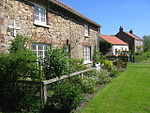Bossall
Bossall is a hamlet in North Yorkshire, England with fewer than 100 residents. The village was part of the Ryedale district between 1974 and 2023. It is now administered by North Yorkshire Council. The Church of St Botolph was built in the 12th century with later alterations and is a Grade I listed building. The term Bosall was drawn from the name of 7th-century bishop Bosa of York who was said to have built a church here. The community is mentioned in the Domesday Book as Boscele and as Bosciale in the hundred of Bulford; at that time, the property was held by "Hugh, son of Baldric" or Hugh fitzBaldric and included a church. In 1086, there were 19 residents in approximately 6.9 households, in addition to a priest. This property produced an annual income of "3 pounds in 1086; 2 pounds 10 shillings in 1066". Records from 1823 indicate that there were only three houses and a population of 31, increasing to 76 by 1842; archaeological evidence showed that the village was previously much larger. It is thought to have been devastated by the Black Death in 1349. Centuries ago, the community included a quadrangular castle built in the 1300s by Paulinus de Bossall which was replaced by the current manor built in the 17th century; stone from the original castle walls was used in that project. By 1923, there was no village per-se here, "the church having in close proximity only the rectory, a modern building, and Bossall Hall".
Excerpt from the Wikipedia article Bossall (License: CC BY-SA 3.0, Authors).Bossall
Geographical coordinates (GPS) Address Nearby Places Show on map
Geographical coordinates (GPS)
| Latitude | Longitude |
|---|---|
| N 54.038055555556 ° | E -0.90444444444444 ° |
Address
YO60 7NT , Buttercrambe with Bossall
England, United Kingdom
Open on Google Maps









